We use machine learning technology to do auto-translation. Click "English" on top navigation bar to check Chinese version.
Simulating Automotive E/E Architectures in Amazon Web Services – Part 1: Accelerating the V-Model
Over the last 15 years, the complexity of automotive Electrical/Electronic (E/E) architectures which include Electronic Control Units (ECUs), related sensors, actuators, and wiring inside vehicles has grown. Rather than continuing to add new hardware components to E/E architectures, automakers are shifting towards consolidating smaller, fixed-function ECUs into a larger High Performance Computer (HPC) while retaining a smaller number of purpose-built distributed ECUs. This brings advantages to automakers, including but not limited to, reduction in wiring and weight of the vehicle. With the compute capabilities of these HPCs, automakers are creating entire software platforms with
This blog series is comprised of two parts. In part 1, we explain the trends in automotive E/E architectures and the general concepts and challenges automakers face around simulation of ECU software utilizing the cloud. In
Modern Automotive E/E architectures
Recent automotive E/E architectures address the complexity of managing many single function modules by consolidating related functions on domain controllers. These “domain centralized architectures” contain main computational units for each major domain like ADAS (Advanced Driver Assistance Systems) and Powertrain. The domain controllers communicate with one another, through a gateway, to allow cross-domain functions like monitoring status of ADAS applications on a screen related to the infotainment domain. Sensors and actuators are connected to domain controllers through automotive buses like CAN, LIN, or automotive Ethernet.
As automakers consider ways to further reduce the number of components, “vehicle-centralized architectures” are gaining more popularity. The functionality provided within Domain controllers can now further be consolidated and replaced by single digit HPCs. Through high-speed Ethernet connections, the HPCs communicate with Zonal ECUs. A handful of them are positioned at certain geographic points throughout the vehicle and connected to all sensors and actuators around their location. This reduces the wiring inside the vehicle, as outlined in Figure 1.

Figure 1: Conceptual E/E Architecture diagram
The decreasing number of physical ECUs does not reduce testing and validation efforts for automotive software. Vehicle-centralized architectures make more complex automotive software (e.g., cross-domain) possible, enabling additional connectivity (e.g., V2X), continuous software updates, and new software features over the lifecycle of the vehicle.
Automotive Software Development Model
In modern software development, developers use
However, in the automotive industry, there are design standards in place, such as
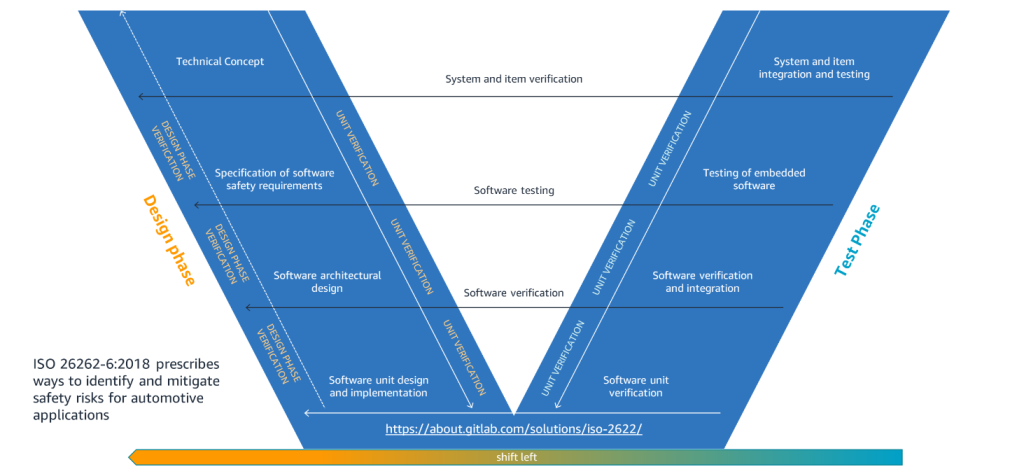
Figure 2: Automotive V-Model Development Process
During the design phase, developers define the system design, specifications, and requirements up front before validation is started in the test phase. This process can result in delayed release cycles and the late discovery of bugs and errors. It is clear that automakers need a way to use the speed and agility provided by modern DevOps while still supporting the design standards required by the industry.
“Shift-Left”
Amazon Web Services and dSPACE are working to “Shift-left” the validation and verification of vehicle centralized architecture systems using simulation technologies in the cloud. These simulation techniques help enable the automotive industry to accelerate the verification process typically defined within the V-model, by running test cases in parallel. This involves moving testing activities earlier in the development cycle and enabling it at scale in the cloud, rather than waiting for the right side of the process where problems are harder and more expensive to fix. By catching defects earlier using cloud native DevOps and simulation, engineers can reduce the risk of costly errors, and can help improve overall quality of the software. Shift-left testing also help enables cost reduction and speed to market as it allows for more frequent feedback loops and earlier identification of costly problems.
While the Shift-left model increases the number of tests needed in a full software environment, it does not diminish the need for system and integration using hardware in the loop (HiL) systems. Instead, the Shift-left model simply increases focus on testing earlier in the development cycle. Automotive software development teams can use more agile development methods provided via cloud native DevOps by quickly iterating over the V-model with more cost effective SiL testing. Applying these methods within their development processes improve quality and remain true to the intent of the V-model.
Simulation Model
Before combining fully virtual simulation systems, conducting experiments, and automating tests, all components of the E/E architecture have to be suitable for a virtual environment. For vehicle-centralized architectures, these components include Edge, Zonal ECUs and HPCs. In the case where it is not possible to obtain a virtual ECU, a simulation model can be created to emulate the characteristics of actual sensors and actuators. There are several types of simulation models available and they can be categorized as plant, environment or restbus models. In order to establish communication between all virtual components, it is important to also set up virtual I/O connections and buses where needed. Figure 3 shows a representative block diagram of our target simulation system.
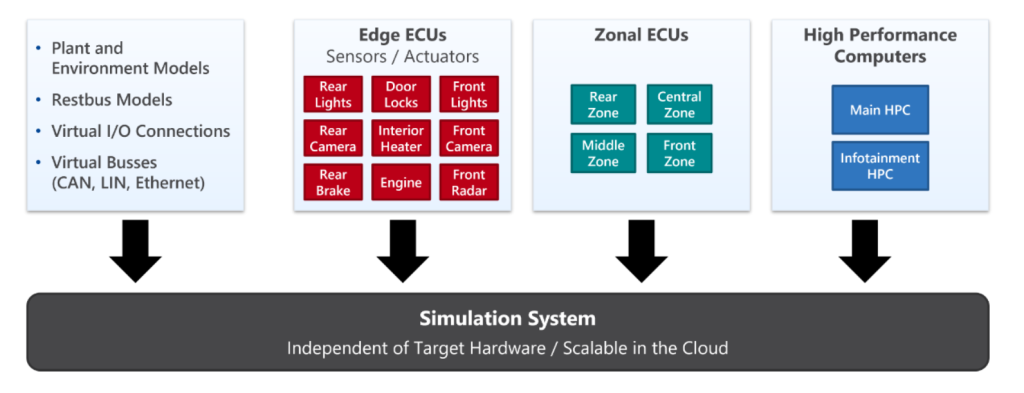
Figure 3: Simulation System I/O and Model Representation
Virtualizing all the control units is key to creating virtual simulation systems. To explain the general approach, we consider the following high-level sketch of four major layers of ECUs and HPCs in Figure 4.
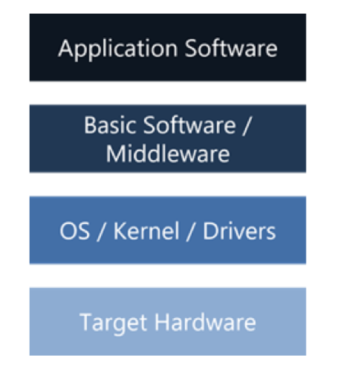
Figure 4: ECU layers block diagram
Instead of depending on the target hardware with specific peripherals and connections, the components need to be enabled to run within development environments decoupled from the target hardware.
To further illustrate, it is helpful to distinguish between two types of operating systems relevant in zonal architectures:
Edge and Zonal ECUs are commonly built atop an OSEK-like OS. They run on microcontrollers and are very suitable for embedded programming because of their small footprint and optimization for real-time applications. The
dSPACE VEOS Cloud Based Simulation
dSPACE VEOS is a simulation platform for ECU software validation. It supports a wide range of different models, such as function models, Functional Mock-up Units (FMUs), virtual ECUs (V-ECUs), and vehicle models, independent of any specific simulation hardware.
VEOS also covers bus simulation needs related to virtual ECU networks as it can simulate automotive Ethernet, CAN, and LIN bus communication, including all bus-specific effects, without additional hardware.
With its open interfaces to connect and use existing tools, VEOS also supports
VEOS runs on standard PCs (Windows and Linux) and is easy to integrate into cloud-based solutions, which gives function developers, software architects, and ECU testers a variety of valuable options for SiL testing.
To simulate Edge and Zonal ECUs, VEOS provides an adjusted OS that allows us to execute the application layer and further parts of the basic software in VEOS and thus in x86 environments.
VEOS provides several modules to abstract I/O and bus drivers. So, we can run OSEK-based components and connect them on I/O and bus level.
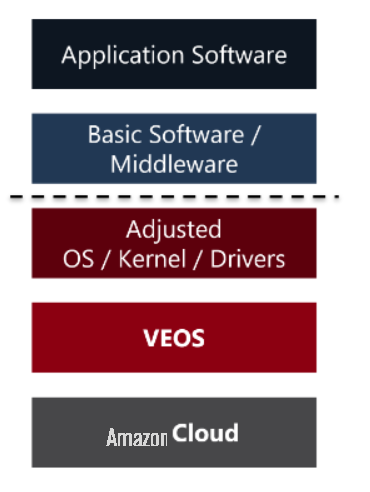
By adjusting the “OS / Kernel / Drivers” layer, it is also possible to avoid chip simulation and achieve reasonable performance of simulations. Of course, the adjustments must not have heavy impact on the behavior to produce meaningful simulation results.
The other category, POSIX, are commonly related to the High-Performance Computers (HPCs) in a zonal architecture. HPCs are closer to IT servers in terms of performance, architecture and provide capabilities to execute demanding algorithms while needing to remain highly reliable.
While being performant they need to be energy efficient and the automakers have adopted Arm-based processors as the computational core of such HPCs in combination with HW accelerators. They are already preferred choice in several domains like in-vehicle infotainment and ADAS and they are expected to become the computational enabler of the SDV (Software-defined vehicle).
Amazon Web Services Graviton for HPC Simulation
Amazon Web Services provides custom-built 64-bit Arm-based processors called
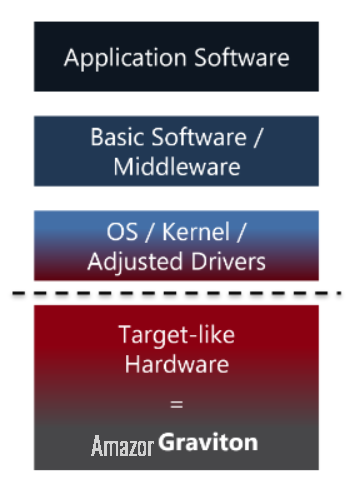
However, it is important to note that Amazon Web Services Graviton based systems are not 100% identical to SoCs and ECUs utilized in the vehicle. For example, there is no physical CAN bus on these cloud systems. Amazon Web Services and dSPACE are helping to deliver value by unlocking and enhancing SIL capabilities much earlier in the development cycle. Therefore it also follows that HiL validation will remain a requirement. Aspects such as CPU parity can be considered directly and differences in input and output can be further simulated using replayed messaging. Automotive engineers can also simulate or emulate the hardware peripherals that are not present in the system.
For this approach to be successful, we also have to ensure that we have the software vendors developing hypervisors and operating systems utilized in the automotive space are also running on Amazon Web Services Graviton. Today, we have several Amazon Machine Images (AMIs) that are used in automotive already ported to work natively on Amazon Web Services Graviton, such as
Conclusion
Join us for
For more details regarding this solution, Please contact
The mentioned AWS GenAI Services service names relating to generative AI are only available or previewed in the Global Regions. Amazon Web Services China promotes AWS GenAI Services relating to generative AI solely for China-to-global business purposes and/or advanced technology introduction.

